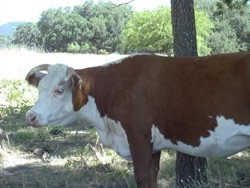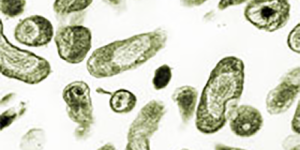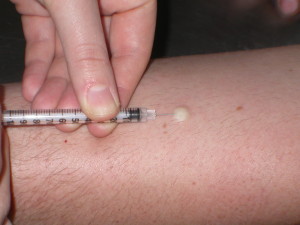Q Fever is a zoonotic disease caused by the intracellular bacteria Coxiella burnetii, a species of alpha-Proteobacteria related to Legionella pneumophila. It is robust and one of the most infectious organisms and is usually acquired by the inhalation of particles from infected animals.
The disease is distributed globally and is a scheduled WorkCover compensable disease in Australia.
Incubation period
The incubation period is 14-39 days.
Features
Most commonly, a mild influenza-like illness occurs, but more severe symptoms and serious complications – pneumonia, hepatitis, endocarditis, Post Q-Fever Debility Syndrome (PQDS) – sometimes occur. Hepatomegaly occurs in 50% of cases.
Many people infected with Q Fever may show little or no signs of illness.
The duration of the initial illness is 2 days to 2 weeks after which it usually resolves without permanent effects. However, complications such as endocarditis, osteomyelitis, arteritis and granulomatous disease of liver and testes, may develop after 3-20 years and may be fatal. “10–15% of patients experience a protracted post‐Q fever fatigue syndrome. Chronic Q fever, which may develop years after infection, is usually characterised by endocarditis, but may also include osteomyelitis and hepatitis.”
Pregnant Women
Women infected with Q fever during pregnancy are at high risk for developing chronic Q fever, possibly because of a failure to mount an appropriate immune response to acute infection or the ability of C. burnetii to use placental trophoblasts as a replicative niche. The earlier during pregnancy a woman is infected, the greater her risk for development of chronic disease. After a diagnosis of new onset acute infection, treatment throughout pregnancy is recommended to decrease the risk for an adverse birth outcome as well as the risk for future development of chronic Q fever. Chronic infection might be evidenced by increased phase I IgG C. burnetii titers that do not decrease after pregnancy and can lead to adverse outcomes during subsequent pregnancies.
Coxiella burnetti can be resistant to heat and desiccation, and is highly infectious by the aerosol route. A single inhaled organism may produce clinical illness. Indeed, in [non-human] primates, the dose to kill 50 per cent of the primates was found to be 1.7 organisms. It therefore has some potential in biological warfare.
Q-Fever is a vaccine-preventable disease. It is a notifiable disease in Victoria.
Australia
Every year, some 575 cases are notified in Australia – mainly from Queensland and New South Wales. Some doctors in Queensland have deemed it necessary to administer the vaccine to rural youth, even though it has not been approved for children, because of the high-risk of Q fever in the area.
In 2000, the Australian Government (and then the states), introduced a vaccination program for abattoir workers, cattle and sheep farmers and others working in the meat industry. A study, in 2018, of blood donors in Qld and NSW suggested an incidence so high in both rural and urban environments that “vaccination against Q fever should be considered for all rural residents” in these states.
International
The disease was reported to be endemic to California during the 1950s. In certain regions of Europe (The Netherlands, France and Spain) the organism is highly prevalent, being the second most common etiology of community-acquired pneumonia and causing 5-8% of endocarditis cases.
Multiple reports of clusters have been described for many years, especially from Europe, Israel and the USA.
Vaccine Information.
Australia is the only nation which utilises a vaccine for the prevention of Q-Fever.
The vaccine used to protect against Q-Fever is Q-Vax, a purified suspension of formalin-inactivated C.burnetii. Special care with the vaccine is required as severe reactions may occur. Revaccination is contraindicated.
Testing requires two visits to a health provider about one week apart. People who test positive are immune and don’t receive the vaccine. People who test negative can be safely vaccinated.
 Vaccines cannot be given without prior skin testing and antibody checking – done on the same day.
Vaccines cannot be given without prior skin testing and antibody checking – done on the same day.
Immunity to Q Fever typically develops about 15 days after vaccination. If you have been vaccinated and you work in a high risk environment, you should not commence work until after this time.
If you test positive and do not need the vaccine you are protected and can start work once your results are confirmed – usually once your record is entered onto the Q Fever Register.
Animal vaccines
Large scale vaccination of cattle in Slovakia and Bulgaria appears to have been effective. This has been accomplished with an inactivated phase 1 vaccine.
In Israel, an inactivated bivalent vaccine (combined with chlamydia) has been used in small ruminants.
Treatment
Doxycycline is the treatment of choice for acute Q fever.
Antibiotic treatment is most effective when initiated within the first 3 days of illness.
The Australian Q Fever Register was established in 2002 and provides information on the immune status of individuals by password access.
History
Q-fever was first described in 1935 by Edward Holbrook Derrick in abattoir workers in Brisbane, Australia. The “Q” stands for “query” and was applied at a time when the causative agent was unknown.
The pathogen of Q fever was discovered in 1937, when Frank Macfarlane Burnet and Mavis Freeman isolated the bacterium from one of Derrick’s patients.
It was originally identified as a species of Rickettsia. H.R. Cox and Gordon Davis elucidated the transmission when they isolated it from ticks in Montana, USA in 1938.



